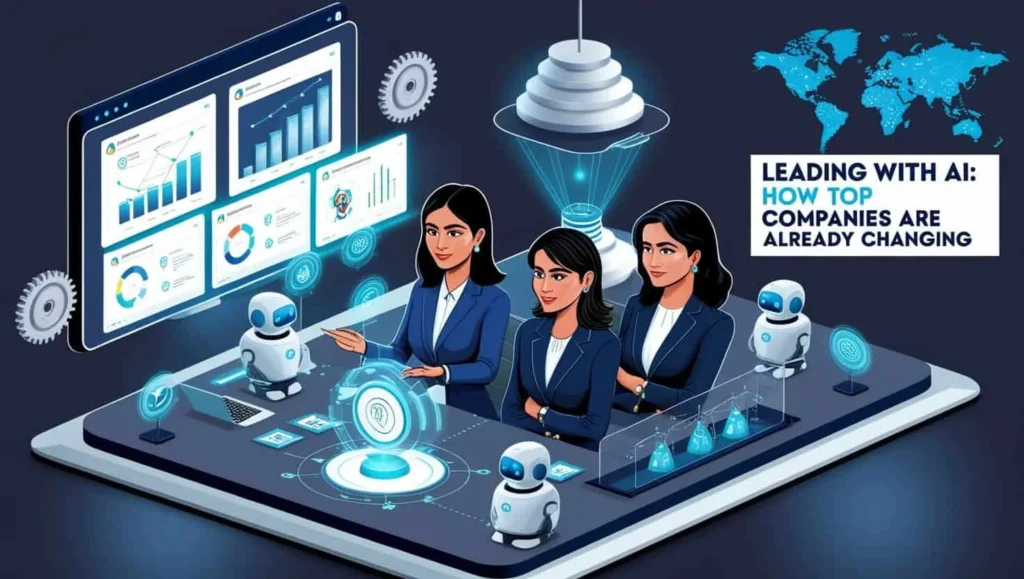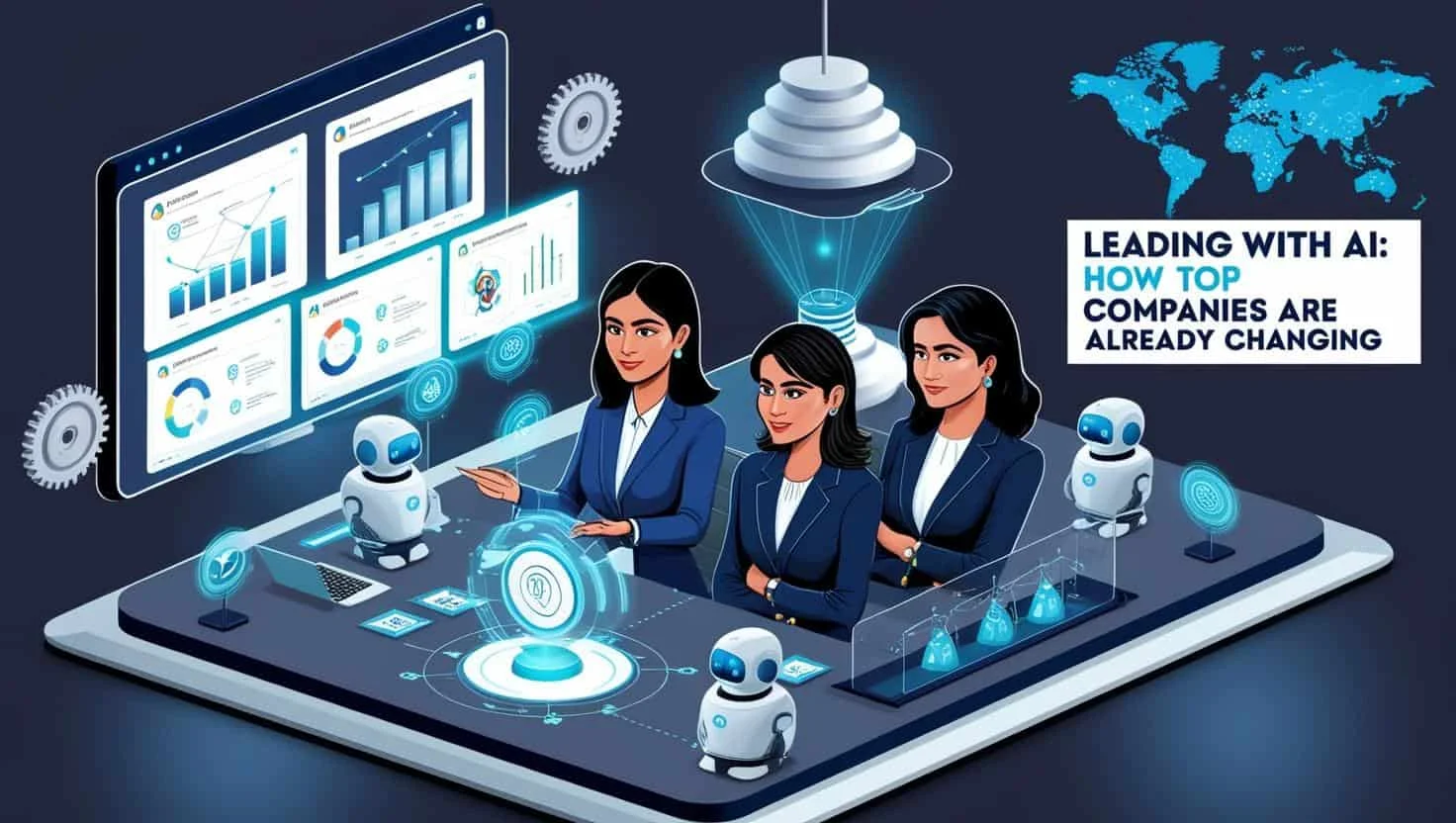Discover how top companies use AI to innovate, enhance customer experience, and lead with purpose. Real-world insights, stories, and lessons for modern leaders.
How Top Companies Use Ai
Artificial intelligence, you can’t treat it as a passing fad any longer.
The world below self-proclaimed titles: Organizations have innovative tech engines ensured to boost business efficiency and predictive customer behavior, among other things. But this isn’t a technological irony; this is how a leader chooses to capitalize on that. That is the game-changer.
How precisely industry tycoons have employed AI techniques to breathe in real-matter impact? Further most probably, what can the rest learn from them?
Now let’s take a sneak peek behind the curtain.

It All Starts With a Mindset Shift
Today, we shall discuss mindset before proceeding to the algorithms and automation attached to it.
True AI companies do not just install cool software and hope on it. They are businesses that face their whole business model. You can think of Amazon: they do not just use AI to persuade you into reading more books; they optimize their entire supply chain through machine learning, which includes pricing strategy and everything else related to it.
As Jeff Bezos aptly put it, “We are happy to be misunderstood by very long time.” That is commitment to the long game. That’s exactly what allows one to invest early in AI when few answers are known.
It is not just these two.
Netflix: Turning Data Into Delight
If you’ve ever watched a whole series until 2 a.m., Netflix’s machine method has certainly been at work.
Netflix has quite some deep stuff beneath that complex algorithm which, yes, is used to personalize recommendations. Their AI can, for instance, identify what it would fund in original content; this will also help editors select the best thumbnails, which will likely get clicked by users.
It’s about enhancing human imagination and talent, not replacing them.
Thus, one would ask, What keeps viewers watching? When do they hit “pause,” rewind, or give up on something? Those answers affect not just the way they interact with our product, but the actual DNA of how their content is created.
That is how great corporations today use artificial intelligence: not to speculate but to know.
Starbucks: Brewing Loyalty with Every Sip
Once you enter a Starbucks, the first impression might not strike you with the elegance of AI, but trust me; it is there.
With the Deep Brew program, Starbucks uses AI to personalize your experience in subtle yet meaningful ways. Deep Brew predicts what drink you might want the most on a rainy Thursday afternoon. It recommends promotions based on your preferences. It helps managers schedule shifts based on local foot traffic patterns.
This careful blending of technology and humanity creates an almost unbeatable loyalty.
And the trick is, they don’t let the barista be replaced by AI: AI is used to make the barista smarter, faster, and more prepared.
Google: AI as the Oxygen of Innovation
When you discuss AI leadership, you cannot fail to mention Google.
It is evident that AI is found almost every time Google is mentioned. From Gmail’s smart replies, real-time rerouting in Maps, to copyright detection system on YouTube, AI is there.
Going open-source with their machine learning library TensorFlow is perhaps the biggest. Immediate effect? It didn’t just keep the magic within its walls; it opened up to literally thousands of external developers across the world.
That’s how major corporations use AI-not just for themselves but to lift an entire ecosystem.
How Top Companies Use AI in Supply Chains
Let’s change it up for a minute.
That is, AI is not limited to being the forte of the tech behemoths. Traditional areas, such as logistics and manufacturing, are also undergoing seismic shifts.
For instance, this is DHL. Automated learning is at work here to enhance its delivery routes, anticipate package delays, and even detect fraud. Smart warehouses have been fitted with self-learning and self-adapting autonomous robots to fulfill orders to be quicker and more secure.
BMW also uses AI to inspect vehicles as they move through production. Real-time cameras are triggered to see by touch while no human eye has yet seen it.
This is what these images tell – the future is already here. It is no longer futuristic; it has hit the world; it’s just how the world operates, builds, and delivers.
The Human Side of the AI Equation
Let’s wind down now.
With all this algorithm and automation talk, it’s easy to forget the human side. But here’s the truth: AI is only as powerful as the people guiding it.
The companies winning with AI are not just tech-heads for tech’s sake. It is about ethical use, transparency, and inclusivity. They hire ethicists, use diverse voices in data training, and run into audits with their models.
Because they know that trust is currency.
When Microsoft’s AI chatbot Tay went bad on Twitter, it was a big learning moment on why governance matters. Salesforce’s AI-infused Einstein system has been built around the idea of responsible AI. So it’s not a question of Can we use AI? but Should we? And how?
Lessons from the Front Lines
So what do you make of all this?
First, there is no cookie-cutter solution with AI. Instead, it is a tool-very mighty, indeed-but it requires guidance, vision, and soul.
Second, one does not need to be Google to start. Many smaller companies utilize AI to answer customer queries via email, for demand forecasting, and to automate routine tasks.
Since culture counts, companies that lead in AI integrate innovation into their DNA. They foster curiosity, reward experimentation, and accept failures as useful lessons.
Bringing It All Together
If there is one thing that connects all these stories, it is this: AI does not replace leadership; it amplifies it.
When used intentionally, AI provides leaders the insight to make good decisions and to foster environments in which strong relationships can flourish and suitable experiences for all stakeholders can be created.
In other words, the way that the top companies are using AIs does not come down to secret algorithms or big budgets but to commitment, courage, and caring.
Think about it: In which areas could AI make your teams faster instead of colder? Where will it help strip away friction rather than ostentatious ease?
For when we lead with AI, all the while consciously, ethically, and courageously, we are not just following; we are setting the narrative for tomorrow.
Are you ready to lead with AI?


2 thoughts on “Leading with AI: How Top Companies Use AI”